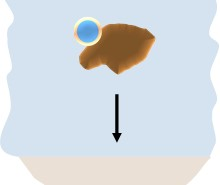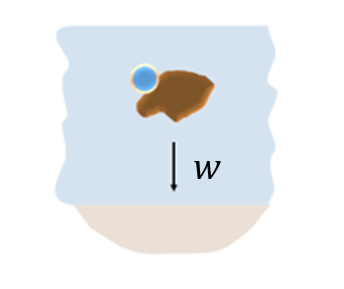Sedimentation rate
Sedimentation rate
Irrespective of their density, nanoparticles (diameter below 100 nm) are expected not to settle/sediment, because the slow sedimentation movement is overwhelmed by the fast diffusion of the particles. Free nanoparticles are thought to move with the water (advective transport) and must aggregate or heteroaggregate to SPM to acquire a substantial sedimentation rate. Also, when the water flows in a turbulent manner, as in a river, the movement of particles is more influenced by the turbulent water flow than by the downward fall of sedimentation.
There are multiple approaches to calculate the settling velocity, which are applicable to both nanoparticles and SPM. The algorithm links below provide (ii) a general example of settling velocity calculation using Stokes’ law, valid for laminar (non-turbulent) flows, and (iii) a description of the settling velocity calculation for SPM in the NanoFASE water-soil-organism (WSO) model, more accurate for turbulent flows (and thus more applicable to natural rivers). Heteroaggregation of nanoparticles to SPM is a key process in their removal from waters, due to subsequent settling of the sediments. The NanoFASE WSO model does not simulate the settling of free nanoparticles, but models only the sedimentation of SPM to which nanoparticles may be attached.
|
|
Used for |
 Sedimentation |
Algorithms |
|
|
\(k_{settle}=\frac{w}{D}\) |
(i) Calculation of settling rate from settling velocity \(w\) and river depth \(D\). |
| \(w=\frac{2(\rho _{\rho }-\rho _{f})gr^{2}}{9\mu }\) | (ii) A general example of calculating settling velocity using Stokes’ law, valid for laminar (non-turbulent) flows. |
| \(w_{\text{spm}} = \frac{\eta}{d} d_*^3 \left( 38.1 + 0.93 d_*^{12/7} \right)^{-7/8}\) | (iii) Settling velocity of SPM as calculated in the NanoFASE WSO model, more applicable for natural rivers with turbulent flows. |
Read more |
Read also |
|
Visit the NanoFASE Library to see summaries of deliverable reports: |
|
Contact
 Frank von der Kammer
Frank von der Kammer
University of Vienna, Austria
Email: frank.von.der.kammer@univie.ac.at
 Stephen Lofts
Stephen Lofts
Centre for Ecology and Hydrology (CEH), UK
Email: stlo@ceh.ac.uk

